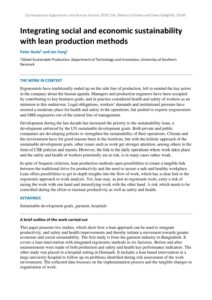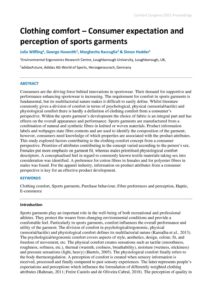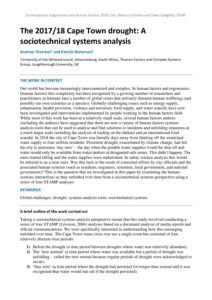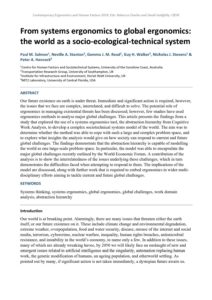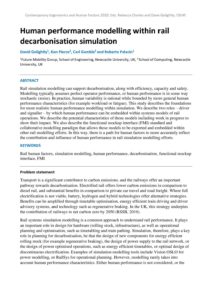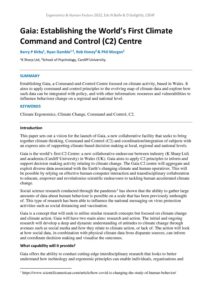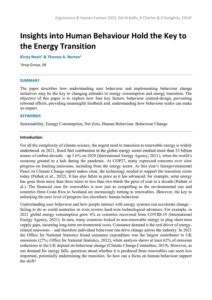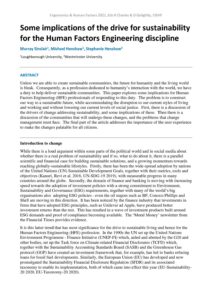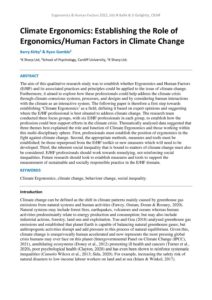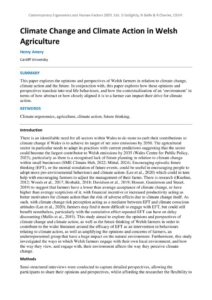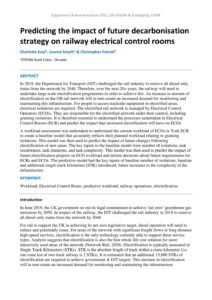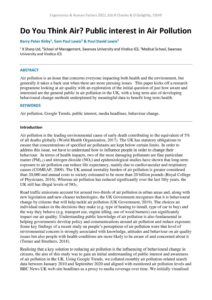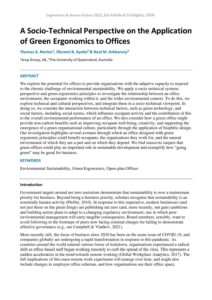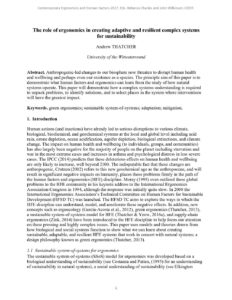Climate change
Integrating social and economic sustainability with lean production methods
| Document | Author Peter Hasle and Jan Vang |
| Abstract Ergonomists have traditionally ended up on the side line of production, left to remind the key actors in the company about the human agenda. Managers and production engineers have been occupied by contributing to key business goals, and in practice considered health and safety of workers as an intrusion to this endeavour. Legal obligations, workers’ demands and institutional pressure have secured a moderate place for health and safety in the operations, but pushed to experts (ergonomists and OHS engineers) out of the central line of management. Development during the last decade has increased the priority to the sustainability issue, a development enforced by the UN sustainable development goals. Both private and public companies are developing policies to strengthen the sustainability of their operations. Climate and the environment have for good reasons been in the forefront, but with the holistic approach of the sustainable development goals, other issues such as work get stronger attention, among others in the form of CSR policies and reports. However, the link to the daily operations where work takes place and the safety and health of workers potentially are at risk, is in many cases rather weak. In spite of frequent criticism, lean production methods open possibilities to create a tangible link between the traditional drive for productivity and the need to secure a safe and healthy workplace. Lean offers possibilities to get in-depth insights into the flow of work, which has a clear link to the ergonomic approach to work analysis. Yet, lean may, as just as ergonomic tools, carry a risk of easing the work with one hand and intensifying work with the other hand. A risk which needs to be controlled during the effort to increase productivity as well as safety and health. |
Clothing comfort – Consumer expectation and perception of sports garments
The 2017/18 Cape Town drought: A sociotechnical systems analysis
| Document | Author Andrew Thatcher and Patrick Waterson |
| Abstract Our world has become increasingly interconnected and complex. In human factors and ergonomics (human factors) this complexity has been recognised by a growing number of researchers and practitioners as humans face a number of global crises that seriously threaten human wellbeing (and possibly our own existence as a species). Globally-challenging issues such as energy supply, urbanisation, health provision, violence and terrorism, food supply, and water scarcity have now been investigated and interventions implemented by people working in the human factors field. While most of this work has been at a relatively small scale, several human factors authors (including the authors) have suggested that there are now a variety of human factors systems analysis tools that can be used to analyse and find solutions to incidents and unfolding situations at a much larger scale including the analysis of trading on the darknet and an international food scandal. In 2018 the city of Cape Town was literally days away from shutting off the municipal water supply to four million residents. Persistent drought, exacerbated by climate change, had led the city to announce ‘day zero’ – the day when the potable water supplies would be shut off and water would only be available from water tankers at designated safe zones. This didn’t happen. The rains started falling and the water supplies were replenished. In safety science analysis this would be referred to as a near miss. Was this luck or the result of concerted efforts by city officials and the associated human systems (such as residents, engineers, scientists, local government, and national government)? This is the question that we investigated in this paper by examining the human-systems interactions as they unfolded over time from a sociotechnical systems perspective using a series of four STAMP analyses. |
From systems ergonomics to global ergonomics: the world as a socio-ecological-technical system
| Document | Author Paul M. Salmon, Neville A. Stanton, Gemma J. M. Read, Guy H. Walker, Nicholas J. Stevens & Peter A. Hancock |
| Abstract Our future existence on earth is under threat. Immediate and significant action is required, however, the issues that we face are complex, interrelated, and difficult to solve. The potential role of ergonomics in managing existential threats has been discussed; however, few studies have used ergonomics methods to analyse major global challenges. This article presents the findings from a study that explored the use of a systems ergonomics tool, the abstraction hierarchy from Cognitive Work Analysis, to develop a complex sociotechnical systems model of the world. The aim was to determine whether the method was able to cope with such a large and complex problem space, and to explore what insights the analysis would give on how society can respond to current and future global challenges. The findings demonstrate that the abstraction hierarchy is capable of modelling the world as one large-scale problem space. In particular, the model was able to encapsulate the major global challenges recently outlined by the World Economic Forum. A contribution of the analysis is to show the interrelatedness of the issues underlying these challenges, which in turn demonstrates the difficulties faced when attempting to respond to them. The implications of the model are discussed, along with further work that is required to embed ergonomics in wider multi-disciplinary efforts aiming to tackle current and future global challenges. |
Human performance modelling within rail decarbonisation simulation
| Document | Author David Golightly, Ken Pierce, Carl Gamble and Roberto Palacin |
| Abstract Rail simulation modelling can support decarbonisation, along with efficiency, capacity and safety. Modelling typically assumes perfect operator performance, or human performance is in some way stochastic (noise). In practice, human variability is rational while bounded by more general human performance characteristics (for example workload or fatigue). This study describes the foundations for more realistic human performance modelling within simulation. We describe two roles – driver and signaller – by which human performance can be embedded within systems models of rail operations. We describe the potential characteristics of those models including work in progress to show their impact. We also describe the functional mockup interface (FMI) standard and collaborative modelling paradigm that allows these models to be exported and embedded within other rail modelling efforts. In this way, there is a path for human factors to more accurately reflect the contribution and influence of human performance in rail simulation modelling efforts. |
Gaia: Establishing the World’s First Climate Command and Control (C2) Centre
| Document | Author Barry P Kirby, Ryan Gamble, Rob Honey & Phil Morgan |
| Abstract Establishing Gaia, a Command-and-Control Centre focused on climate activity, based in Wales. It aims to apply command and control principles to the evolving map of climate data and explore how such data can be integrated with policy, and with other information: resources and vulnerabilities to influence behaviour change on a regional and national level. |
Insights into Human Behaviour Hold the Key to the Energy Transition
| Document | Author Kirsty Novis & Thomas A. Norton |
| Abstract The paper describes how understanding user behaviour and implementing behaviour change initiatives may be the key to changing attitudes to energy consumption and energy transition. The objective of this paper is to explore how four key factors; behaviour centred-design, preventing rebound effects, providing meaningful feedback and, understanding how behaviour scales can make an impact. |
Some implications of the drive for sustainability for the Human Factors Engineering discipline
| Document | Author Murray Sinclair, Michael Henshaw and Stephanie Henshaw |
| Abstract Unless we are able to create sustainable communities, the future for humanity and the living world is bleak. Consequently, as a profession dedicated to humanity’s interaction with the world, we have a duty to help deliver sustainable communities. This paper explores some implications for Human Factors Engineering (HFE) professionals of responding to this duty. The problem is to construct our way to a sustainable future, while accommodating the disruption to our current styles of living and working and without lowering our current levels of social justice. First, there is a discussion of the drivers of change addressing sustainability, and some implications of these. Then there is a discussion of the communities that will undergo these changes, and the problems that change management must face. The final part of the article addresses the importance of the user experience to make the changes palatable for all citizens. |
Climate Ergonomics: Establishing the Role of Ergonomics/Human Factors in Climate Change
| Document | Author Barry Kirby & Ryan Gamble |
| Abstract The aim of this qualitative research study was to establish whether Ergonomics and Human Factors (E/HF) and its associated practices and principles could be applied to the issue of climate change. Furthermore, it aimed to explore how these professionals could help address the climate crisis through climate-conscious systems, processes, and designs and by considering human interactions with the climate as an interactive system. The following paper is therefore a first step towards establishing ‘Climate Ergonomics’ as a field, defining it based on expert opinions and suggesting where the E/HF professional is best situated to address climate change. The research team conducted three focus groups, with six E/HF professionals in each group, to establish how the profession could best support efforts in the climate crisis. Thematically analysed data suggested that three themes best explained the role and function of Climate Ergonomics and those working within this multi-disciplinary sphere. First, professionals must establish the position of ergonomics in the fight against climate change. Second, the appropriate methods, measures and tools must be established; be those repurposed from the E/HF toolkit or new measures which will need to be developed. Third, the inherent social inequality that is bound to matters of climate change must also be considered. E/HF professionals should work towards remedying, not reinforcing social inequalities. Future research should look to establish measures and tools to support the measurement of sustainable and socially responsible practice in the E/HF domain. |
Climate Change and Climate Action in Welsh Agriculture
| Document | Author Henry Amery |
| Abstract This paper explores the opinions and perspectives of Welsh farmers in relation to climate change, climate action and the future. In conjunction with, this paper explores how these opinions and perspectives translate into real life behaviours, and how the contextualisation of an ‘environment’ in terms of how abstract or how closely aligned it is to a farmer can impact their drive for climate action. |
Predicting the impact of future decarbonisation strategy on railway electrical control rooms
| Document | Author Charlotte Kaul, Joanne Smyth & Christopher Patrick |
| Abstract In 2018, the Department for Transport (DfT) challenged the rail industry to remove all diesel-only trains from the network by 2040. Therefore, over the next 20+ years, the railway will need to undertake large scale electrification programmes in order to achieve this. An increase in amount of electrification on the GB rail network will in turn create an increased demand for monitoring and maintaining this infrastructure. For people to access trackside equipment in electrified areas, electrical isolations are required. The electrified rail network is managed by Electrical Control Operators (ECOs). They are responsible for the electrified network under their control, including granting isolations. It is therefore essential to understand the processes undertaken in Electrical Control Rooms (ECR) and predict the impact that increased electrification will have on ECOs. A workload assessment was undertaken to understand the current workload of ECOs in York ECR to create a baseline model that accurately reflects their planned workload relating to granting isolations. This model was then used to predict the impact of future changes following electrification of new areas. The key inputs to the baseline model were number of isolations, task occurrences, task durations, and task complexity. This model was then used to predict the impact of future electrification projects on ECO workload and inform decisions about future requirements for ECRs and ECOs. The predictive model had the key inputs of baseline number of isolations, baseline and additional single-track kilometres (STK) introduced, future increases to the complexity of the infrastructure. |
Do You Think Air? Public interest in Air Pollution
| Document | Author Barry Peter Kirby, Sam Paul Lewis & Paul David Lewis |
| Abstract Air pollution is an issue that concerns everyone impacting both health and the environment, but generally it takes a back seat when there are more pressing issues. This paper kicks off a research programme looking at air quality with an exploration of the initial question of just how aware and interested are the general public in air pollution in the UK, with a long term aim of developing behavioural change methods underpinned by meaningful data to benefit long term health. |
A Socio-Technical Perspective on the Application of Green Ergonomics to Offices
| Document | Author Thomas A. Norton, Oluremi B. Ayoko & Neal M. Ashkanasy |
| Abstract We explore the potential for offices to provide organisations with the adaptive capacity to respond to the chronic challenge of environmental sustainability. We apply a socio-technical systems perspective and green ergonomics principles to investigate the relationship between an office environment, the occupants working within it, and the wider environmental context. To do this, we explore technical and cultural perspectives, and integrate these in a socio-technical viewpoint. In doing so, we consider the interaction between technical factors, such as green technology, and social factors, including social norms, which influence occupant activity and the contribution of this to the overall environmental performance of an office. We also consider how a green office might provide non-carbon benefits such as improving occupant well-being, creativity, and supporting the emergence of a green organisational culture, particularly through the application of biophilic design. Our investigation highlights several avenues through which an office designed with green ergonomic principles could benefit occupants, the organisations they work for, and the natural environment of which they are a part and on which they depend. We find reason to suspect that green offices could play an important role in sustainable development and exemplify how “going green” may be good for business. |
The role of ergonomics in creating adaptive and resilient complex systems for sustainability
| Document | Author Andrew THATCHER |
| Abstract Anthropogenic-led changes to our biosphere now threaten to disrupt human health and wellbeing and perhaps even our existence as a species. The principle aim of this paper is to demonstrate what human factors and ergonomics can learn from the study of how natural systems operate. This paper will demonstrate how a complex systems understanding is required to unpack problems, to identify solutions, and to select places in the system where interventions will have the greatest impact. |

